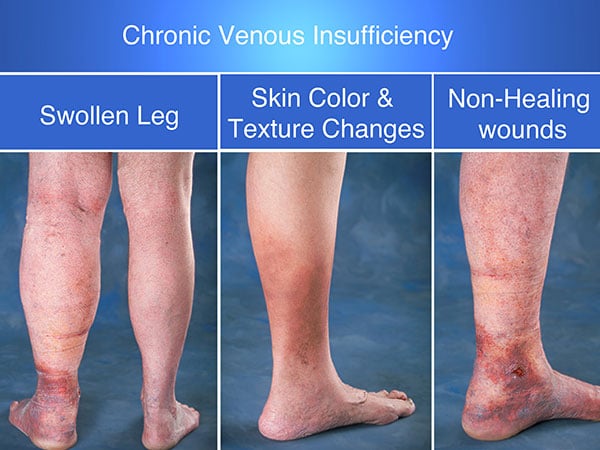What is Chronic Venous Insufficiency?
Chronic Venous Insufficiency (CVI) is a condition that develops over months or years from malfunctioning valves in the veins of the legs. Normally functioning valves prevent the backflow of blood down the legs and keeps the blood moving back towards the heart. However, the broken valves in a patient with CVI do not hold a seal and blood pressure builds up in the lower legs leading to pooling of the blood called venous stasis. This results in swelling and skin changes.

What Causes Chronic Venous Insufficiency?
Anything that can physically damage the valves in the veins can lead to Chronic Venous Insufficiency (CVI). Two common causes are deep vein thrombosis and superficial venous thrombosis. These are both conditions where blood clots form in the veins. Once the clot dissolves, they leave scar tissue and permanent damage on the valves preventing them from opening and closing properly. Also, some patients are predisposed to malfunctioning valves due to genetics and their family history. This may be known to the patient if their parents or grandparents had varicose veins. Women with multiple pregnancies are at a higher risk of developing chronic venous insufficiency.
Pelvic tumors and vascular malformations, leading to abnormal flow of blood and pressure gradients in the vasculature can lead to chronic venous insufficiency. Additionally, chronic venous insufficiency is associated with being overweight. Finally, weakness in the leg muscles that squeeze blood back to the heart can also contribute to the development of venous insufficiency.
What Are Symptoms of Chronic Venous Insufficiency?
Chronic Venous Insufficiency (CVI) begins with small varicose veins, and can gradually progress to larger veins. As new veins develop and symptoms worsen, the legs may experience swelling. This tends to occur more with long periods of standing or sitting. The swelling, when present for long periods of time, can lead to iron (hemosiderin) deposition in the skin known as lipodermatosclerosis. Later in the disease process, leg ulcers develop that require additional medical treatment to heal.
Symptoms of Chronic Venous Insufficiency include:
- Swelling of the legs or ankles (edema)
- Pain that worsens with prolonged sitting or standing
- Pain that improves with leg elevation
- Pain when walking that relieves with rest
- Cramping of the legs
- Throbbing sensation in the legs
- Achy feeling in legs
- Heaviness feeling in the legs
- Itchy skin and sensation in the legs
- Thickening of the skin with “woody” changes
- Skin around the ankles changing colors to red or brown
- Wounds on the lower legs that do not heal, usually around and above the ankles
- Newly formed varicose veins
- Abnormally flaky skin, or abnormally moist skin
- Tightness in the calves
The later CVI is detected, the harder it can be to treat. Luckily, since CVI is a chronic condition, often times slowly progressing disease, the later symptoms can be avoided with proper education, surveillance and screening. If a patient notices these symptoms, consider consulting with a physician at Precision VIR for evaluation and management of CVI. To schedule an appointment with our CVI specialists in Dallas TX metroplex please call us at 214-382-3200 or complete the form below.

What Factors Contribute to Chronic Venous Insufficiency?
CVI is more common in women, and especially those with multiple pregnancies. Patients with trauma to the legs which physically damaged the veins, or a past history of blood clots are also more likely to developing CVI. Obese patients and those which are middle-aged or older are more prone to develop chronic venous insufficiency.
How Is Chronic Venous Insufficiency Diagnosed?
The expert doctors at Precision VIR conduct a physical exam and take a complete medical history to determine if you have venous insufficiency. Our specialists may also use imaging tests, such as a duplex venous and arterial ultrasound, conventional venogram or CT venogram to properly diagnose your vascular diagnosis, whether it be a problem with the veins or arteries.
Meet Our Expert DoctorsHow Is Chronic Venous Insufficiency Treated?
The first step in treating CVI is to reduce to pressure in the veins with leg elevation, compression stockings and exercise. These methods increase the flow of blood out of the legs by using gravity and the muscles in your legs to push the blood back up the leg. While compression stockings may be unsightly or problematic, they are an effective tool to augment the venous return from the leg and prevent the progression of CVI.
At Precision VIR, our experienced physicians will recommend a treatment options depending on what is causing the condition in your legs, your health status and history. Other factors that are often considered are:
- Onset, duration, timing, exacerbating and relieving factors of your symptoms.
- Your age
- The severity of your condition
- The presence of ulcers and skin changes
- The past history of blood clots and DVT
- Your ability to tolerate medications and procedures
Treatment for a typical chronic venous insufficiency treatment for patient usually includes compression stockings, leg elevation, exercise, weight loss, moisturizing the skin to prevent cracks and prescription medications. Many patients benefit from venous closure using radio frequency ablation (ClosureFast, previously known as Venefit) and ultrasound guided percutaneous Sclerotherapy. In the most serious cases, venous closure may need to be undergone immediately, for instance to close a venous stasis ulcer. Some cases require a procedure to improve blood flow in the deep veins of the legs, using angioplasty and/or stents. Ultimately, the goals of the therapy implemented by the doctors at Precision VIR is to increase the venous return from the legs, thereby decreasing the symptoms associated with CVI.
Read More About ClosureFastRead More About Sclerotherapy
Schedule an Appointment
Request an appointment for a Chronic Venous Insufficiency evaluation if you’re experiencing any of the following symptoms:
- Pain in the legs, including cramping and aching
- Darkening of the skin around the lower legs, ankles and feet
- Thick skin on the lower legs and ankles
- Swelling of the legs
- Varicose and Spider veins on the legs
To schedule an appointment please call us at 214-382-3200 or complete the form below.
Precision VIR serves the DFW area including Dallas, Fort Worth, Carrollton, Richardson, Garland, Mesquite, Highland Park, University Park, Park Cities, Plano, Frisco, Allen, McKinney, Flower Mound, Lewisville, Denton, Arlington, Irving, Grand Prairie and all of North Texas.
Prior to starting any new treatment or questions regarding a medical condition, always seek the advice of your doctor or other qualified health provider. This information is not a substitute for professional medical advice.
